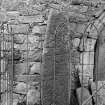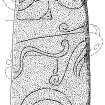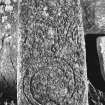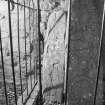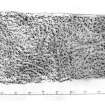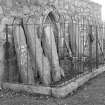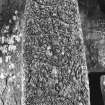Scheduled Maintenance
Please be advised that this website will undergo scheduled maintenance on the following dates: •
Tuesday 3rd December 11:00-15:00
During these times, some services may be temporarily unavailable. We apologise for any inconvenience this may cause.
Tullich, St Nathalan's Kirk, Symbol Stone, Tullich 1
Pictish Symbol Stone (Pictish)
Site Name Tullich, St Nathalan's Kirk, Symbol Stone, Tullich 1
Classification Pictish Symbol Stone (Pictish)
Alternative Name(s) Tullich Churchyard
Canmore ID 229637
Site Number NO39NE 2.02
NGR NO 39050 97548
Datum OSGB36 - NGR
Permalink http://canmore.org.uk/site/229637
- Council Aberdeenshire
- Parish Glenmuick, Tullich And Glengairn
- Former Region Grampian
- Former District Kincardine And Deeside
- Former County Aberdeenshire
Tullich 1 (St Nathalan), Aberdeenshire, Pictish symbol stone
Measurements: H 1.76m, W 0.49m, D 0.15m
Stone type: Andalusite staurolite schist
Place of discovery: NO 3905 9754
Present location: stored off-site for conservation; a new display shelter in the kirkyard is planned.
Evidence for discovery: found in 1866 re-used in the blocking of a doorway in the north wall of the church. It was removed and set in a railed enclosure against the north wall.
Present condition: trimmed along all four edges for secondary use, and the surface is weathered.
Description
This was a tall slab incised with three Pictish symbols: double disc and Z-rod above a Pictish beast, with a mirror below. The discs have an inner concentric circle and a central compass pit. The beast faces right, and the centrally placed mirror has an inner concentric circle and a double ball handle.
Date: seventh century.
References: ECMS, pt 3, 186-7; Michie 1910, 118, 150; Fraser 2008, no 47; Geddes, Murray & Murray 2015, 253, 265-6.
Desk-based information compiled by A Ritchie 2017
Reference (1903)
The symbol stone was discovered by the Rev. John Michie, minister of Dinnet, used as a lintel at the top of a window in the N. wall of the church, and has since been removed and placed within an iron railing against the N. wall of the church, together with several slabs bearing incised crosses and a massive old font.
It is a slab of blue slate, of nearly rectangular shape, 5 feet 9 inches long by 1 foot 9 inches wide by 5 inches thick, sculptured with incised lines on one face thus-
Front.- At the top of the double disc and Z-shaped rod symbol; below this the elephant symbol; and at the bottom the mirror symbol without the comb. The discs are each ornamented with a single concentric circle. The body of the mirror is ornamented with a single circle, not concentric with the outline. The handle of the mirror is of the double disc pattern.
This stone is described and pretty correctly illustrated by Mr Andrew Gibb, FSA Scot., in the Proc. Soc. Ant. Scot. (vol. xii. p. 196).
J R Allen and J Anderson 1903
Field Visit (13 November 1968)
A church, ruined but preserved, situated within a graveyard which is still used. As well as the Pictish symbol stone as described and illustrated by Allen (1903), and the font, there are now 16 Celtic-type cross-slabs within the railed enclosure on the N side of the church. They vary from 0.2m square to 1.5m in height.
Re-surveyed at 1/2500.
Visited by OS (N K B) 13 November 1968.
Desk Based Assessment (1968)
NO39NE 2.00 39054 97543 St Nathalan's Kirk
NO39NE 2.01 39057 97533 Burial-Ground
NO39NE 2.02 39050 97548 Symbol Stone and Cross Slabs
(NO 3905 9754) Church (In Ruins) (NAT) On Site of (NAT) St. Nathalan's Chapel (NR)
OS 6" map, (1938)
A Celtic chapel was established here by Nathalan (W D Simpson 1922), Nachalan (J G Michie 1910), or Neachtan (H Scott 1915-61) who died in AD 678. The church was held by the Knights Templars and latterly by the Hospitallers, (D E Easson 1957) who built a fort around the church in the 13th century, traces of which still remain (A I McConnachie 1898). The present building is a good example of a Medieval parish church, which has been very largely reconstructed in post- Reformation times. A late 14th century doorway remains in the N wall, but the precise date of construction is not known (W D Simpson 1922).
At the door of the church, surrounded by a railing, there is a Pictish symbol stone, found by Michie in 1866, built into the fabric of the church, five grave-slabs each inscribed with a Celtic cross, and an old font (J R Allen and J Anderson 1903). According to Michie, St. Nachalan's cross, a cross-inscribed stone, stood some distance to the E of the churchyard, but it was destroyed in 1857 for road metalling. However, Jervise states that St. Nach'lan's cross, which was 12' high and adorned with steps, was a square unadorned shaft of granite on the site of Nach'lans Fair and which was removed in 1817. (Probably a mis-print).
A Jervise 1875-9; A I McConnachie 1989; J R Allen and J Anderson 1903; J G Michie 1910; H Scott 1915-61; W D Simpson 1922; D Easson 1957.
Information from OS.
Note (2007)
During survey over 2004/05, in addition to the Pictish Symbol Stone and large stone font, RCAHMS recorded 15 cross-slabs, not 16 as stated by OS in 1968.
Information from RCAHMS (JB) 2007














